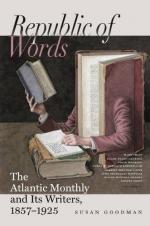* * * * *
My friend has an ardent affection for Walter Scott and Charles Lamb. I find the first edition of “Marmion,” printed in 1808, “by J. Ballantyne & Co. for Archibald Constable and Company, Edinburgh,” most carefully bound in savory Russia, standing in a pleasant corner of the room. Being in quarto, the type is regal. Of course the copy is enriched with a letter in the handwriting of Sir Walter. It is addressed to a personal friend, and is dated April 17, 1825. The closing passage in it is of especial interest.
“I have seen Sheridan’s last letter imploring Rogers to come to his assistance. It stated that he was dying, and concluded abruptly with these words ‘they are throwing the things out of window.’ The memorialist certainly took pennyworths out of his friend’s character.—I sate three hours for my picture to Sir Thomas Lawrence during which the whole conversation was filled up by Rogers with stories of Sheridan, for the least of which if true he deserved the gallows.”
Ever Yours, “WALTER SCOTT.”
In the April of 1802 Scott was living in a pretty cottage at Lasswade; and while there he sent off the following letter, which I find attached with a wafer to my friend’s copy of the Abbotsford edition of his works, and written in a much plainer hand than he afterwards fell into. The address is torn off.
“SIR,
“I esteem myself honored by the polite reception which you have given to the Border Minstrelsy and am particularly flattered that so very good a judge of poetical Antiquities finds any reason to be pleased with the work.—There is no portrait of the Flower of Yarrow in existence, nor do I think it very probable that any was ever taken. Much family anecdote concerning her has been preserved among her descendants of whom I have the honor to be one. The epithet of ‘Flower of Yarrow’ was in later times bestowed upon one of her immediate posterity, Miss Mary Lillias Scott, daughter of John Scott Esq. of Harden, and celebrated for her beauty in the pastoral song of Tweedside,—I mean that set of modern words which begins ‘What beauty does Flora disclose.’ This lady I myself remember very well, and I mention her to you least you should receive any inaccurate information owing to her being called like her predecessor the ‘Flower of Yarrow.’ There was a portrait of this latter lady in the collection at Hamilton which the present Duke transferred through my hands to Lady Diana Scott relict of the late Walter Scott Esq. of Harden, which picture was vulgarly but inaccurately supposed to have been a resemblance of the original Mary Scott, daughter of Philip Scott of Dryhope, and married to Auld Wat of Harden in the middle of the 16th century.
“I shall be particularly happy if upon any future occasion I can in the slightest degree contribute to advance your valuable and patriotic labours, and I remain, Sir,




